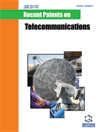Recent Patents on Telecommunication (Discontinued) - Current Issue
Volume 1, Issue 2, 2012
-
-
Contextual Information Acquisition and Management Solutions for IPBased Networks: A Survey
More LessAuthors: May El Barachi and Nadjia KaraAccording to the ITU-T, Next Generation Networks (NGNs) are envisioned as IP-based networks capable of offering their users ubiquitous access to a multitude of feature rich, QoS-enabled, broadband services that combine telecom and datacom flavors. As NGNs continue to evolve, several challenges related to their operation and architecture are being investigated. One of these challenges is the enabling of innovative and Read More
-
-
-
A Method to Transform a Personal Computer into Several Networking Devices
More LessAuthors: M. Ahsan Chishti, Shaima Qureshi and Ajaz H. MirInternet connects millions of computers from around the world and provides communication, storage and high speed computation infrastructure. As such Computer Networks has emerged as one of the most important technological field of our time. Users are joining the internet from every nook and corner of the world and utilising its services in all fields including education and business. Networking devices provide the infra Read More
-
-
-
Interactive Voice Response Mashup System for Service Enhancement
More LessAuthors: Imran Ahmed and Sunil Kumar KopparapuMashup service is common in the realm of web development. Mashup, generally, is a web page that sources two or more data sources to create a new and an improved service. While mashup service is a common phenomenon in the web development scenario, there is no such mashup for services that are based on voice user interface in the Interactive Voice Response (IVR) systems. IVR based telephony services have been Read More
-
-
-
Multi-Scale Profiling of Internet Traffic
More LessAuthors: Eduardo Rocha, Paulo Salvador and Antonio NogueiraInternet can be seen as an ever-changing platform where new types of services and applications are constantly emerging. Consequently, novel communications paradigms are continuously appearing, generating traffic with different network requirements. Besides, the emergence of highly stealth attacks leads to an increasing need of accurately profiling Internet services, by mapping their traffic to the originating application Read More
-
-
-
Calculating Distances Between Wireless Nodes for Wireless Network Localization
More LessAuthors: Israel Martin-Escalona, Francisco Barcelo-Arroyo and Marc Ciurana-AdellThis paper presents a patent targeted to obtain distance measurements between nodes belonging to a wireless network. The main motivation for this patent is the measurement of the distance between a user device and an access point (or base station). After several distance measurements to different access points at sight and assuming the position of the access points known, the device can compute its own position by trila Read More
-
-
-
Enhancing the Efficiency of MANETs by Improving the On-demand Routing Protocols and QoSmetrics
More LessAuthors: Mamatha Balachandra, Prema K.V and Krishnamoorthy MakkithayaA Mobile Ad Hoc Network represents a system of wireless mobile nodes that can freely and dynamically selforganize into arbitrary and temporary network topologies, allowing people and devices to seamlessly communicate without any pre-existing communication architecture. The growth of real time multimedia application in such environments, has drawn a lot of attention to wireless networks that support quality of service ( Read More
-
-
-
An Efficient Hand-Based Biometric Recognition System Using Finger- Knuckle-Print Data
More LessAuthors: Abdallah Meraoumia, Salim Chitroub and Ahmed BouridaneAutomatic personal identification is playing an important role in secure and reliable applications, such as access control, surveillance systems, information systems, physical buildings and many more applications. In contrast with traditional approaches, based on what a person knows (password) or what a person has (tokens), biometric based identification is providing an improved security for their users. Biometrics is t Read More
-
Volumes & issues
Most Read This Month Most Read RSS feed
Article
content/journals/rptelc
Journal
10
5
false
en


